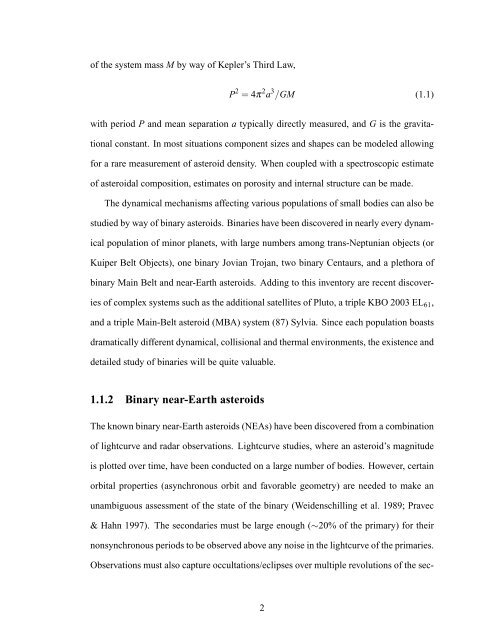Forming Binary Near-Earth Asteroids From Tidal Disruptions
Forming Binary Near-Earth Asteroids From Tidal Disruptions
Forming Binary Near-Earth Asteroids From Tidal Disruptions
You also want an ePaper? Increase the reach of your titles
YUMPU automatically turns print PDFs into web optimized ePapers that Google loves.
of the system mass M by way of Kepler’s Third Law,P 2 = 4π 2 a 3 /GM (1.1)with period P and mean separation a typically directly measured, and G is the gravitationalconstant. In most situations component sizes and shapes can be modeled allowingfor a rare measurement of asteroid density. When coupled with a spectroscopic estimateof asteroidal composition, estimates on porosity and internal structure can be made.The dynamical mechanisms affecting various populations of small bodies can also bestudied by way of binary asteroids. Binaries have been discovered in nearly every dynamicalpopulation of minor planets, with large numbers among trans-Neptunian objects (orKuiper Belt Objects), one binary Jovian Trojan, two binary Centaurs, and a plethora ofbinary Main Belt and near-<strong>Earth</strong> asteroids. Adding to this inventory are recent discoveriesof complex systems such as the additional satellites of Pluto, a triple KBO 2003 EL 61 ,and a triple Main-Belt asteroid (MBA) system (87) Sylvia. Since each population boastsdramatically different dynamical, collisional and thermal environments, the existence anddetailed study of binaries will be quite valuable.1.1.2 <strong>Binary</strong> near-<strong>Earth</strong> asteroidsThe known binary near-<strong>Earth</strong> asteroids (NEAs) have been discovered from a combinationof lightcurve and radar observations. Lightcurve studies, where an asteroid’s magnitudeis plotted over time, have been conducted on a large number of bodies. However, certainorbital properties (asynchronous orbit and favorable geometry) are needed to make anunambiguous assessment of the state of the binary (Weidenschilling et al. 1989; Pravec& Hahn 1997). The secondaries must be large enough (∼20% of the primary) for theirnonsynchronous periods to be observed above any noise in the lightcurve of the primaries.Observations must also capture occultations/eclipses over multiple revolutions of the sec-2












